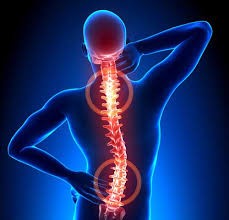How to Eliminate Back Pain (Part 3): Decreasing Upper Back Stiffness
Dr. Troy Vander Molen, PT, DPT
In our June 1, 2018 article entitled 5 Reasons Why Your Back Hurts When You Walk, I outlined the most common root causes of this type of back pain: poor hip mobility, decreased hip strength, stiff upper back, limited foot and ankle mobility, and spine arthritis. In this month’s follow-up installment, I will highlight the problems often caused by stiffness in the mid- to upper back and what you can do to eradicate those problems.
As I often say, a lack of stability at a particular link in the kinetic chain causes your body to display dysfunctional movement at that joint. Likewise, a lack of mobility at a particular joint (or set of joints) also has consequences, but these consequences most often affect neighboring regions, particularly the closest neighbors. This is the case at the mid- to upper back. Poor mobility in this area increases movement demands below at the lower back and above at the neck.
 So, once again, we see that the body part that experiences pain isn’t really the true problem. It is simply the part that is experiencing increased mechanical stress because of the root problem.
So, once again, we see that the body part that experiences pain isn’t really the true problem. It is simply the part that is experiencing increased mechanical stress because of the root problem.
The thoracic spine is an area of the spine that has the least amount of mobility primarily because it is surrounded by the rib cage, which exists to protect several important organs in the thorax. The rib cage is also a connection point to many critical core muscles.
The end result is that, by its design, the thoracic spine area does not move excessively, but that does not mean that movement in this region is not important. It is vital! Poor thoracic mobility can affect the lower back, hip, shoulder, and neck. Unfortunately, though, our daily postures make most of us prone to thoracic tightness.
The following activities are a good start if you need to enhance upper back mobility, but it is always wise to seek the advice of a lower back pain specialist to assess your specific needs and find the exact program to overcome your unique issues. Remember, if you want good outcomes, it is always better to assess than to guess.
- Foam Rolling – There are a ton of ways to use a foam roller to enhance thoracic mobility, and thoracic extension is one motion that can be accentuated. Watch the video below produced by Dan Pope, a physical therapist and certified strength coach. Remember to relax the spine as you move over the roller, because the goal is to gain mobility in multiple vertebral joints. You can accomplish relaxation by focusing on deep breathing techniques. Don’t hold your breath.
https://www.youtube.com/watch?time_continue=68&v=khUFQseeMMc
- Seated Trunk Rotation – This exercise (demonstrated below in a video produced by Jeff Cubos) is done sitting with a tall posture on the front of a chair. An object is placed between the knees, and this object is squeezed to engage the core, which stabilizes the lower back and emphasizes movement at the thoracic spine. If you are doing this exercise correctly, you will feel limitations to rotation with minimal trunk movement.
https://www.youtube.com/watch?time_continue=27&v=LUrgex1xevY
- Quadruped Trunk Rotation – There are few people who understand the importance of a balance between mobility and stability than Eric Cressey, who owns baseball training facilities in Massachusetts and Florida. In the video below, Cressey drives trunk rotation with his arm while in on all fours. To limit lower back rotation, a person should flex the hips (and therefore the lumbar spine) by moving the hips closer to the heels.
https://www.youtube.com/watch?time_continue=3&v=FeORipksAlU
In upcoming installments, the Kinetic Edge team and I will continue to provide practical information on how to eliminate back pain by enhancing foot and ankle mobility (Part 4) and managing spine arthritis and/or stenosis (Part 5). If you can’t wait for that information to be released and you have health insurance benefits that are scheduled to renew at the beginning of 2019, I welcome you to contact us today to set up a thorough evaluation with one of our lower back pain experts. And remember, poor thoracic mobility may also be the root cause of your shoulder or neck pain as well.
Even if you’re not experiencing pain currently but have dealt with it in the past, you’d likely benefit from the help of a knowledgeable physical therapist who can find and fix the issues that contribute to the pain. Fixing those root problems will reduce the likelihood that your pain will return.



